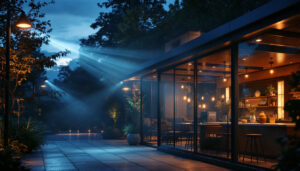

In the ever-evolving world of lighting design and installation, understanding the nuances of the lightbulb market is essential for lighting contractors. As the demand for energy-efficient solutions and innovative designs continues to grow, so does the need for contractors to stay informed about the latest products and trends. This article delves into crucial insights that every lighting contractor should consider when navigating the lightbulb store landscape.
Choosing the right type of lightbulb can significantly impact both the aesthetics and functionality of a space. With a variety of options available, it is vital for contractors to be knowledgeable about the different types of lightbulbs on the market.
Incandescent bulbs have been a staple in lighting for decades. Known for their warm glow and ability to render colors accurately, they are often favored in residential settings. However, their energy inefficiency has led to a decline in popularity as more energy-efficient alternatives have emerged.
Despite their waning popularity, incandescent bulbs still hold value in specific applications. Understanding where and when to use them can help contractors meet client preferences while also providing energy-efficient options. For instance, in settings where ambiance is key, such as dining rooms or living areas, the soft light of incandescent bulbs can create a cozy atmosphere that is hard to replicate with harsher lighting alternatives. Additionally, their compatibility with dimmer switches allows for greater control over light levels, making them an appealing choice for various moods and occasions.
Light Emitting Diodes (LEDs) have revolutionized the lighting industry. With their long lifespan and low energy consumption, they are often the go-to choice for both commercial and residential projects. Contractors should be aware of the various types of LED bulbs available, including dimmable options and color-changing features.
Furthermore, the initial cost of LED bulbs may be higher than traditional options, but their longevity and energy savings make them a worthwhile investment. Educating clients on these benefits can help in promoting LED solutions effectively. Beyond just energy efficiency, LEDs also offer versatility in design; they come in various shapes, sizes, and color temperatures, allowing contractors to tailor lighting solutions to specific needs. For example, warm white LEDs can mimic the inviting glow of incandescent bulbs, while cool white LEDs are ideal for task lighting in kitchens or workspaces. This adaptability makes LEDs suitable for a wide range of applications, from accent lighting to full-room illumination.
Compact Fluorescent Lamps (CFLs) are another energy-efficient alternative to incandescent bulbs. They consume less power and have a longer lifespan, making them a viable option for many applications. However, contractors should inform clients about the proper disposal of CFLs due to their mercury content.
While CFLs are often less expensive than LEDs, they are gradually being overshadowed by the latter due to advancements in LED technology. Contractors should stay updated on the latest developments to provide informed recommendations to clients. Additionally, it is important to note that CFLs can take a moment to warm up and reach their full brightness, which may not be ideal for spaces requiring instant illumination. This characteristic can be a deciding factor for clients who prioritize immediate lighting solutions, especially in high-traffic areas like hallways or entryways. By understanding these nuances, contractors can better navigate client expectations and preferences, ensuring that the chosen lighting solution aligns with both functionality and style.
As sustainability becomes a focal point in the construction and design industries, lighting contractors must prioritize energy-efficient solutions. This not only meets client demands but also aligns with global efforts to reduce carbon footprints. The shift towards sustainable practices is not merely a trend; it reflects a growing awareness of environmental responsibility among consumers and businesses alike. By adopting energy-efficient lighting solutions, contractors can play a pivotal role in promoting a greener future while also enhancing their marketability and reputation.
Familiarity with energy ratings, such as the ENERGY STAR label, is crucial for contractors. These ratings indicate the efficiency of lightbulbs and can guide clients in making informed decisions. Educating clients about the benefits of choosing ENERGY STAR-rated products can enhance their satisfaction and contribute to sustainable practices. Moreover, contractors should also be aware of other certifications, such as the Lighting Facts label, which provides additional information on lumens, wattage, and lifespan, allowing clients to make comprehensive comparisons between products.
Additionally, contractors should be prepared to discuss the long-term savings associated with energy-efficient lighting. By presenting a clear comparison of energy costs over time, contractors can help clients see the value in investing in higher-quality, energy-efficient bulbs. It’s also beneficial to highlight the environmental impact of their choices, such as reduced greenhouse gas emissions and lower energy consumption, which can resonate with clients who are environmentally conscious. Providing case studies or testimonials from previous clients who have experienced significant savings can further reinforce the advantages of energy-efficient lighting.
smart lighting technology is gaining traction in both residential and commercial markets. These systems allow users to control lighting remotely, set schedules, and adjust brightness levels, contributing to energy savings and convenience. The integration of smart lighting not only enhances user experience but also aligns with the growing trend of home automation, making it an appealing option for tech-savvy clients. As smart home devices become more prevalent, the demand for compatible lighting solutions is expected to rise, presenting contractors with new opportunities for growth.
Contractors should familiarize themselves with various smart lighting options available in lightbulb stores. Being able to recommend integrated systems that work with existing setups can set contractors apart from competitors. Furthermore, understanding compatibility with smart home systems can enhance the overall client experience. Offering demonstrations of how these systems operate can also be a powerful selling point, as clients can visualize the convenience and efficiency these solutions bring to their daily lives. Additionally, contractors might explore partnerships with smart technology providers to offer bundled services, making it easier for clients to transition to a fully integrated smart lighting system.
Staying abreast of current trends in lighting design is essential for contractors looking to provide cutting-edge solutions. The aesthetic appeal of lighting can significantly influence a space’s ambiance and functionality.
The trend toward minimalism continues to shape lighting design. Clean lines and simple fixtures are favored in modern spaces, allowing for a more open and airy feel. Contractors should consider how lightbulbs can complement minimalist designs, focusing on fixtures that enhance rather than overwhelm a space.
Incorporating adjustable lighting solutions can also cater to the minimalist aesthetic, allowing clients to modify their environment based on mood or activity.
Layered lighting, which involves combining ambient, task, and accent lighting, is gaining popularity in both residential and commercial projects. This technique creates depth and dimension within a space, enhancing its overall appeal.
Contractors should be equipped to advise clients on how to effectively layer different types of lighting. Understanding how to balance various light sources can lead to more dynamic and functional spaces, ultimately resulting in higher client satisfaction.
When it comes to purchasing lightbulbs, navigating the lightbulb store can be overwhelming due to the sheer variety of options available. Contractors can benefit from adopting best practices to streamline their purchasing process.
Establishing strong relationships with lightbulb suppliers can provide contractors with access to exclusive deals, product knowledge, and timely updates on new releases. Regular communication with suppliers can also help contractors stay informed about industry trends and innovations.
Furthermore, suppliers often provide valuable resources, such as training sessions and product demonstrations, which can enhance contractors’ expertise and service offerings.
Effective inventory management is crucial for contractors who want to maintain a steady flow of projects. Keeping track of lightbulb stock levels and understanding which products are in high demand can prevent delays and ensure timely project completion.
Utilizing inventory management software can simplify this process, allowing contractors to monitor stock levels, track orders, and forecast future needs based on project schedules.
Educating clients about lighting options and their benefits is a critical aspect of a contractor’s role. Clear communication can foster trust and lead to repeat business and referrals.
When presenting proposals, contractors should include detailed information about the lightbulbs being recommended. This can encompass energy efficiency ratings, expected lifespan, and cost comparisons. Providing this information empowers clients to make informed decisions.
Visual aids, such as charts or images, can also enhance proposals, making it easier for clients to understand the benefits of different lighting solutions.
After completing a project, following up with clients can demonstrate commitment to their satisfaction. This can include checking in on how the lighting is performing and addressing any concerns they may have.
Offering ongoing support can also lead to additional business opportunities, as satisfied clients are more likely to refer contractors to friends and family or return for future projects.
The lighting industry is constantly evolving, and staying informed about the latest trends, technologies, and products is essential for lighting contractors. By understanding the different types of lightbulbs, prioritizing energy efficiency, and keeping abreast of design trends, contractors can enhance their service offerings and meet client expectations effectively.
Moreover, building strong relationships with suppliers, managing inventory efficiently, and maintaining clear communication with clients can set contractors apart in a competitive market. Ultimately, the key to success lies in a contractor’s ability to adapt and innovate in response to the ever-changing landscape of lighting solutions.
Ready to elevate your lighting game? At LumenWholesale, we provide lighting contractors with the highest quality, spec-grade lighting products at prices that can’t be beaten. Say goodbye to local distributor markups and hello to our extensive selection that meets rigorous industry standards. With free shipping on bulk orders, we ensure you get the best value without any hidden costs. Don’t compromise on quality or affordability. Discover wholesale lighting at the best value and make LumenWholesale your go-to for reliable, high-performance lighting solutions.

Discover effective cost-saving strategies for lighting contractors using commercial LED strip lights.

Discover expert tips and insights on selecting and installing LED factory lights tailored for lighting contractors.

Discover how kitchen under counter lighting can transform your cooking space from ordinary to extraordinary.

Discover the essential insights lighting contractors need to understand about dryer outlets.
Get notified when NEW deals are released.
Optimize your budget with wholesale discounts.
Only top-quality, specification-grade lighting products.
No additional costs at checkout - what you see is what you pay.
We understand the unique needs of contractors.